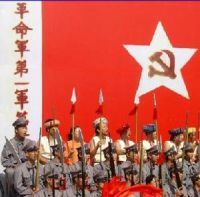Red Tour
The Red Tour refers to a tourist route which tracks the most important sites marking the historical evolution of the Communist Party of China (CPC) during its formative years of 1921-1949. The tour generally begins at the birthplace of the Party in Shanghai and ends at Xibaipo, Hebei Province, the headquarters of the CPC when the victory over the Kuomintang in China’s Civil War (1945-1949) was announced. The tour encompasses the CPC’s former revolutionary bases, the former residences of prominent figures, notable Party meeting sites, abandoned jails and memorial halls. Along the trail, each place tells the story of complicated bygone era, replete with poverty, repression and uprising. The following sites are a few of the tour’s most important stops.
Site of the first National Congress of CPC, Shanghai:
Not long after the October Revolution in Russia, the CPC held its first meeting in Shanghai in July 1921. However, the meeting was interrupted by a spy and the CPC members had to reconvene the meeting on a tourist boat near Jiaxing, Zhejiang Province.
Zunyi Conference Memorial Museum:
After Chiang Kai-shek purged CPC members from the Kuomintang in 1927, the CPC organized the Red Army to fight against Chiang’s repression. However, due to poor strategy, the Red Army was almost defeated in 1935. At a critical moment, the CPC held a meeting in Zunyi, Guizhou Province, where the Party reconfirmed Mao Zedong’s military leadership and changed its war strategy. In the following 370 days, the army hiked 12,500 kilometers from Guizhou into rural Shaanxi Province, far away from Chiang’s grip. They built their own bases in Shaanxi’s northwestern villages and set up their command center in Yan’an. The Zunyi Conference is considered a turning point of CPC’s revolutionary history.
Red capital Yan’an:
Yan’an, Shaanxi Province was the Red Army’s command center during the War Against Japanese Aggression (1937-1945) and the Chinese Civil War (1945-1949). It is considered a Mecca for China’s communist revolution and has attracted a number of overseas sympathizers, including Edgar Snow, Agnes Smedley, Norman Bethune and Israel Epstein.
Xibaipo:
Xibaipo, Hebei Province was the CPC’s final headquarters prior to its victory over the Kuomintang to end the Chinese Civil War (1945-1949). CPC leaders transferred to the village in 1948, one year before the founding of People’s Republic of China. It was the command center for three important wars during the Civil War, including Liaoshen, Huaihai and Pingjin, during which the People’s Liberation Army annihilated 144 Kuomintang regular divisions, guaranteeing its victory. On March 5 to 13, 1949, the CPC held the Second Plenary of the 7th Conference of CPC, the preparatory meeting for the overall liberation of China, in the village. Ten days after the meeting, the CPC moved its headquarters toBeijing.
